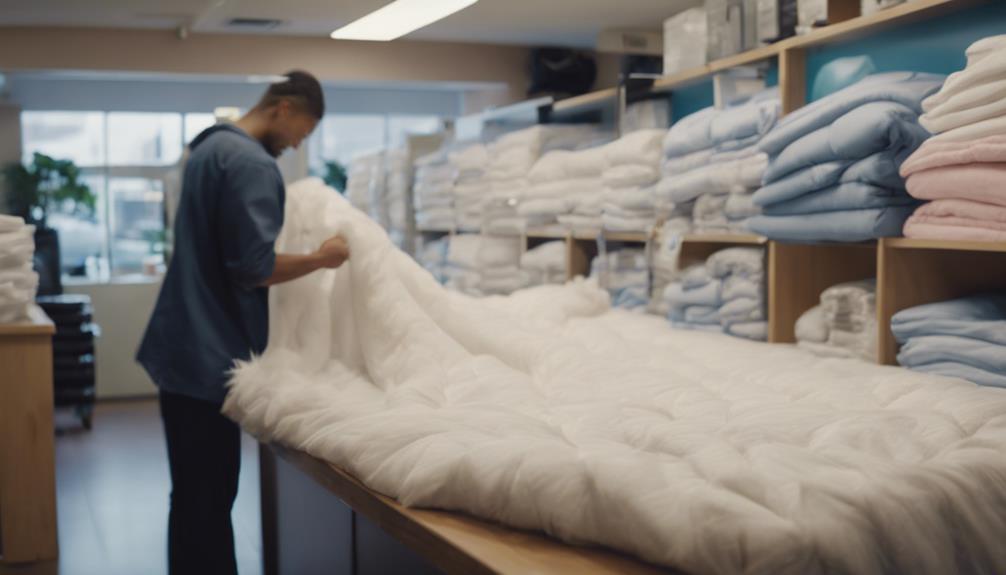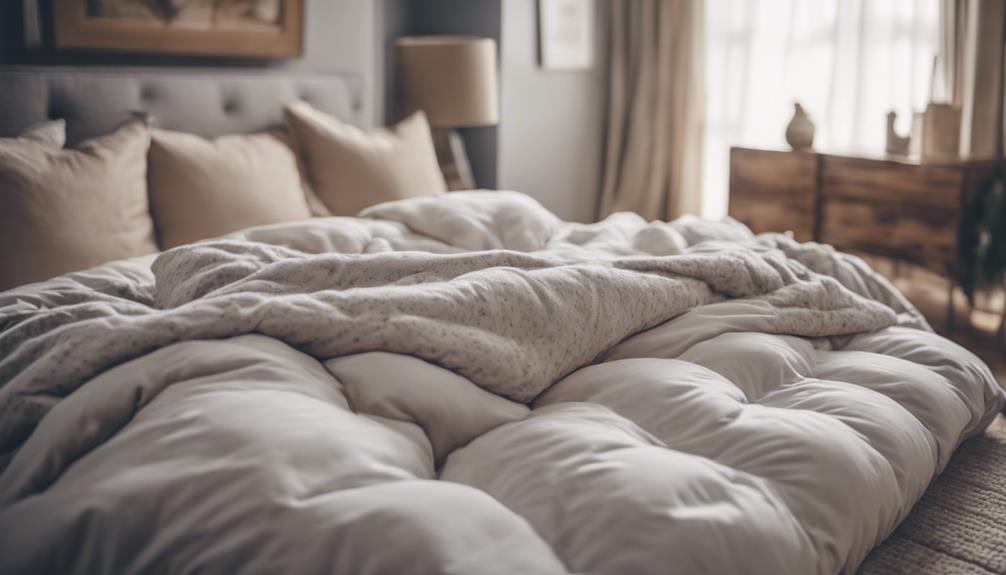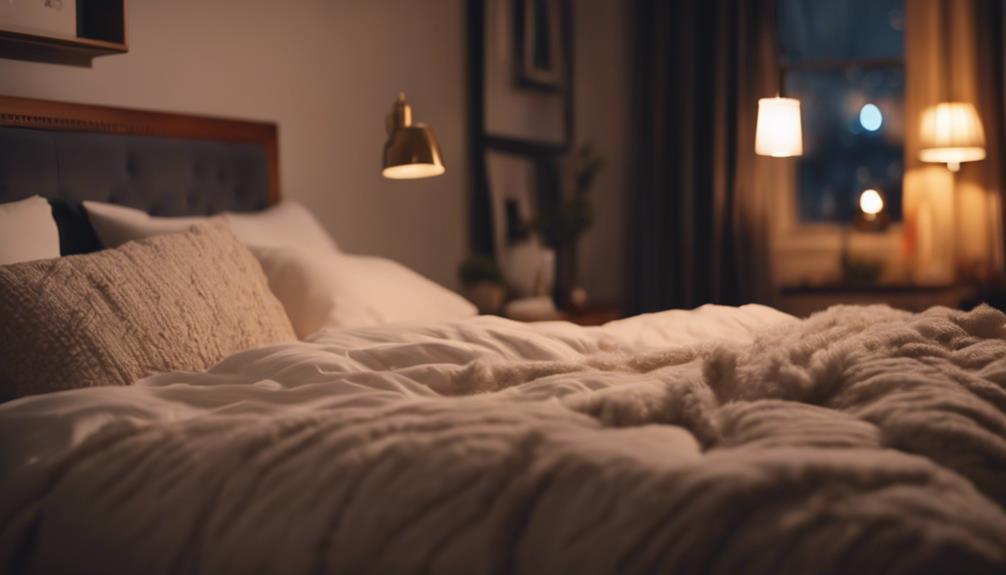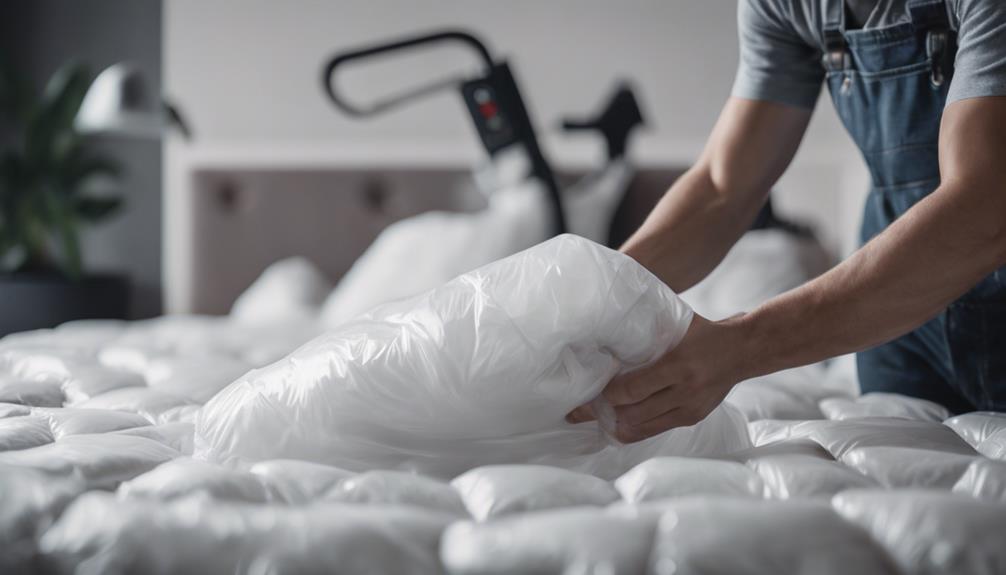When you take a down comforter to be dry cleaned, you can expect to pay between $30 and $50. King size comforters may be more expensive due to additional materials and labor. Additional charges may apply for special fabrics or damages. The cost can vary depending on cleaning supplies, labor, service, taxes, and optional repairs such as mending holes. Factors that affect pricing include size, fabric, equipment, location of the dry cleaner, as well as the type and condition of the comforter. To find ways to save on dry cleaning or to learn more about do-it-yourself cleaning versus professional services, consider further exploration.
Key Takeaways
- Cost ranges from $30 to $50, with larger sizes costing more due to increased material and labor.
- Additional charges may apply for delicate or damaged fabrics, requiring extra time and attention.
- Factors affecting cost include size, materials, equipment, location, and extra services like mending holes.
- Save on expenses with membership discounts, at-home cleaning kits, and washing machine-friendly options.
- DIY cleaning requires machine washable confirmation, gentle detergent, and thorough drying to prevent damage.
Dry Cleaning Cost Breakdown
When contemplating the cost of dry cleaning a down comforter, understanding the breakdown of expenses is essential. The cost for dry cleaning a down comforter can range from $30 to $50, depending on the size.
Larger sizes, like king size comforters, tend to be on the higher end of this range due to the increased material and labor required. Delicate fabrics and damaged materials may also incur additional costs as they necessitate special care during the dry cleaning process. These extra charges are often associated with the extra time and attention needed to properly clean and preserve these delicate fabrics.
Factors such as cleaning supplies, labor, service, and taxes all play a role in determining the final cost of dry cleaning a down comforter. Additionally, extra services like mending holes can add to the overall expense, making it crucial to take into account all these factors when estimating the total cost.
Factors Affecting Dry Cleaning Cost
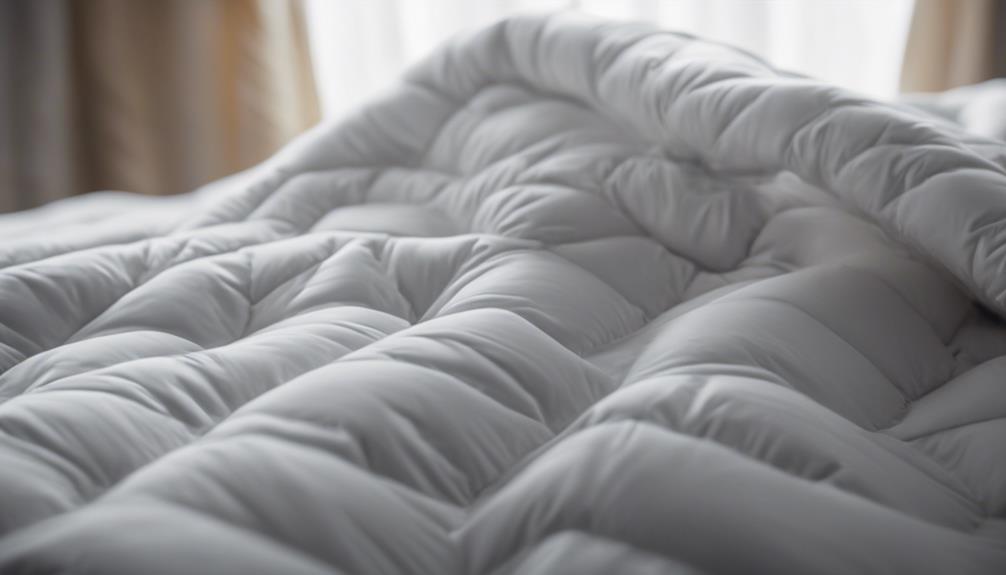
Factors that impact the cost of dry cleaning a down comforter include the size of the comforter, the materials used, the cleaning equipment, and the location of the dry cleaner. Larger comforter sizes, delicate fabrics that require special care, damaged fabric that needs extra attention, modern cleaning machines used for high-quality cleaning, and being in a high standard living area can all influence the final cost of dry cleaning.
To reduce the cost of dry cleaning, consider using washing machine-friendly bedding that can be cleaned at home, utilizing specialized DIY cleaning kits for certain fabrics, seeking discounts as a regular customer, and exploring alternatives that don't require dry cleaning. By being mindful of these factors and taking proactive steps to manage the cleaning process, you can potentially lower the overall expenses associated with keeping your down comforter fresh and clean.
Saving on Dry Cleaning Expenses
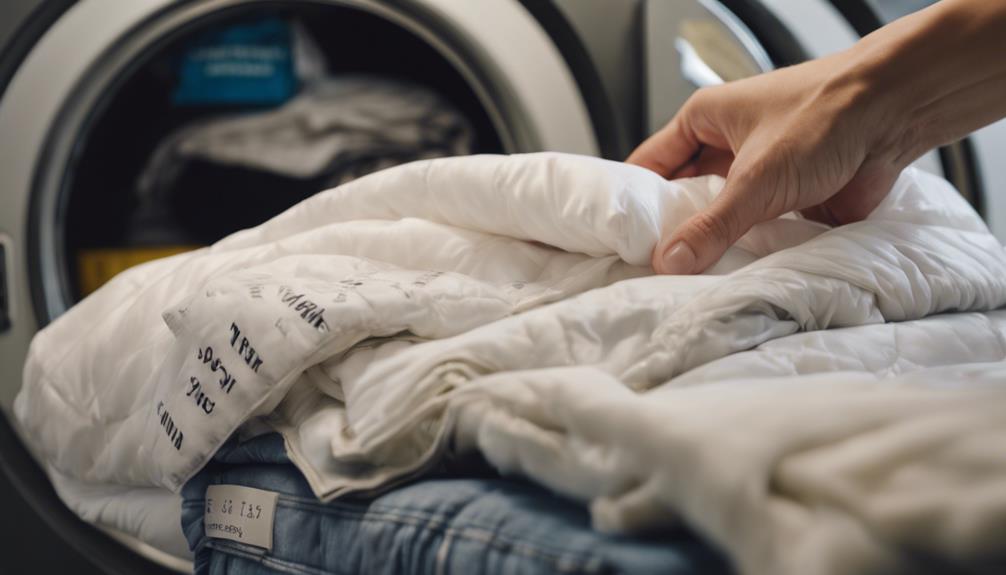
To save on dry cleaning expenses for a down comforter, exploring membership services or seeking regular customer discounts can be beneficial. Many dry cleaners offer discounts or loyalty programs for repeat customers, which can help lower the cost of getting your down comforter cleaned. By taking advantage of these savings opportunities, you can make the process more affordable.
Additionally, considering alternatives like using at-home DIY cleaning kits or opting for bedding that doesn't require dry cleaning can also help you save money in the long run. These alternatives can be cost-effective solutions to keep your down comforter clean without the need for professional dry cleaning services.
When looking to cut down on the cost of dry cleaning your down comforter, it's worth exploring different options and discounts available from dry cleaners to find the best savings for your specific needs.
DIY Vs Professional Cleaning
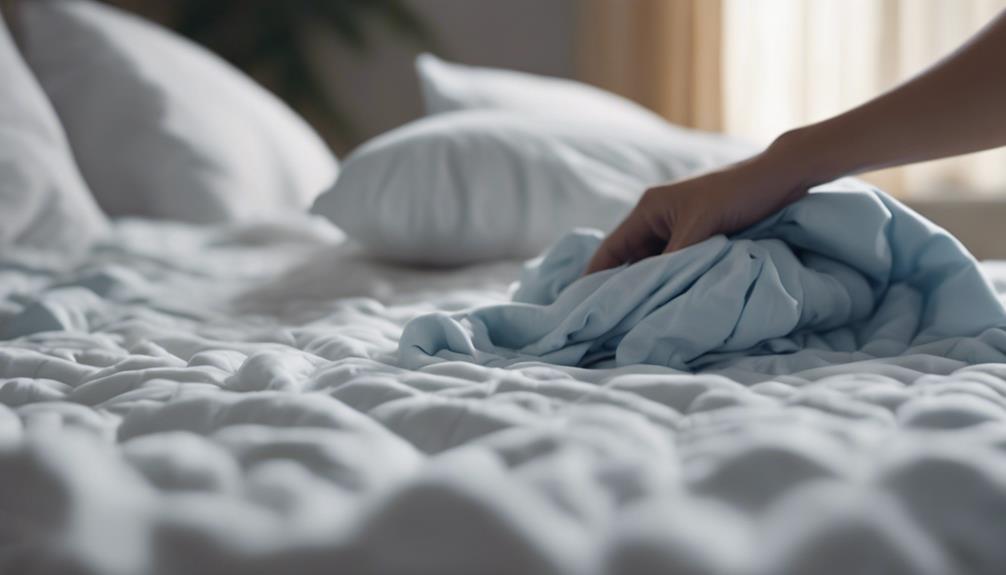
Exploring the choice between DIY and professional cleaning for down comforters is crucial for cost-saving considerations and maintenance effectiveness. Here are some key points to ponder:
- Machine Washable: Confirm your comforter is machine washable before attempting to clean it at home to avoid damaging the delicate down filling.
- Proper Care: Follow care instructions carefully, use a gentle detergent, and wash on a low heat setting to prevent clumping of the down.
- Dry Completely: After washing, make sure the comforter is thoroughly dried to prevent mold and mildew growth.
- Harsh Chemicals: Avoid using harsh chemicals when cleaning a down comforter at home, as they can damage the filling and affect its fluffiness.
While DIY cleaning can be cost-effective, professional laundering may be worth the investment to ensure proper care and maintenance of your down comforter without the risk of damage from incorrect cleaning methods.
Tips for Storing Down Comforters
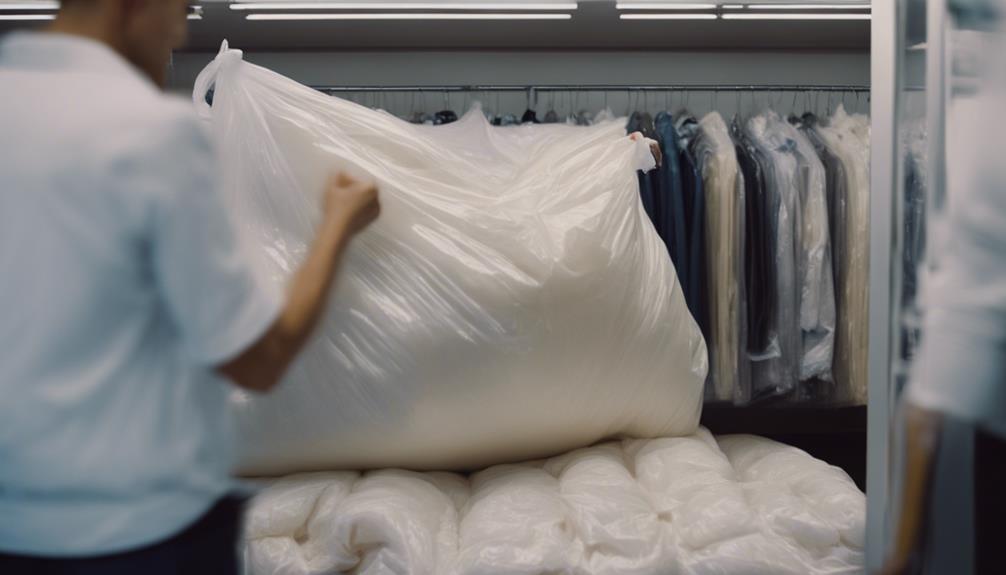
Implementing proper storage techniques is essential for maintaining the quality and longevity of your down comforter.
To store your comforter correctly, use a breathable cloth bag to prevent moisture buildup and odors. Avoid compressing the comforter during storage to keep its fluffiness and loft intact.
When taking it out of storage, give the comforter a good shake to restore its loft and fluffiness. Implement regular care routines such as shaking, washing duvet covers, and spot cleaning to make sure your down comforter stays in top condition.
Storing the comforter in a breathable cloth bag during off-seasons is important to prevent moisture buildup and maintain its quality. By following these tips, you can prolong the lifespan of your down comforter and enjoy its warmth and comfort for years to come.
Frequently Asked Questions
Should I Take My Down Comforter to the Dry Cleaners?
We recommend taking your down comforter to the dry cleaners if it needs a thorough cleaning. It can cost between $30 to $50, depending on the size.
Not all cleaners offer this service, so it's best to check beforehand. Dry cleaning can help prevent shrinkage, but it may expose the down to harsh chemicals.
It's a convenient option if time is a concern, but using a duvet cover can reduce the need for frequent cleanings.
How Expensive Is It to Dry Clean a Down Comforter?
Dry cleaning a down comforter can range from $30 to $50, depending on its size. Additional fees may apply for repairs or special treatments. Costs include supplies, labor, services, and taxes, which vary by location and material. Larger comforters like king size may cost more.
Opting for home washing can be cheaper, depending on care instructions.
How Do You Wash a Down Comforter That Says Dry Clean Only?
If a down comforter is labeled 'dry clean only,' it's best to follow those instructions to prevent damage.
While washing at home can be risky, professional laundering is recommended to avoid harsh chemical damage.
Costs for dry cleaning a down comforter typically range from $30 to $50 depending on size.
Not all dry cleaners provide this service, so it's wise to inquire first.
Following care label instructions is essential to maintain the comforter's quality.
How Often Should You Clean a Down Comforter?
Cleaning a down comforter is crucial for maintaining its quality. With a duvet cover, aim for every 3-5 years; without one, clean every 1-2 years. Spot clean stains to prolong time between washes.
Daily fluffing helps maintain loftiness and even distribution of down. Store it in a breathable cloth bag during off-seasons to prevent odors. Proper care extends its lifespan and guarantees cozy nights for years to come.
What Factors Contribute to the Cost of Dry Cleaning a Down Comforter?
When considering the down comforter dry cleaning cost, several factors play a role. The size of the comforter, the materials used, and any special treatments required all impact the overall cost. Additionally, the location and reputation of the dry cleaner can also affect the final price.
Conclusion
To summarize, the cost of dry cleaning a down comforter can vary depending on factors such as size, material, and location. By understanding these factors and exploring options for saving on expenses, individuals can make informed decisions about how to care for their comforters.
Whether choosing to DIY or seek professional cleaning services, it's important to follow proper storage techniques to guarantee the longevity and quality of the comforter.
